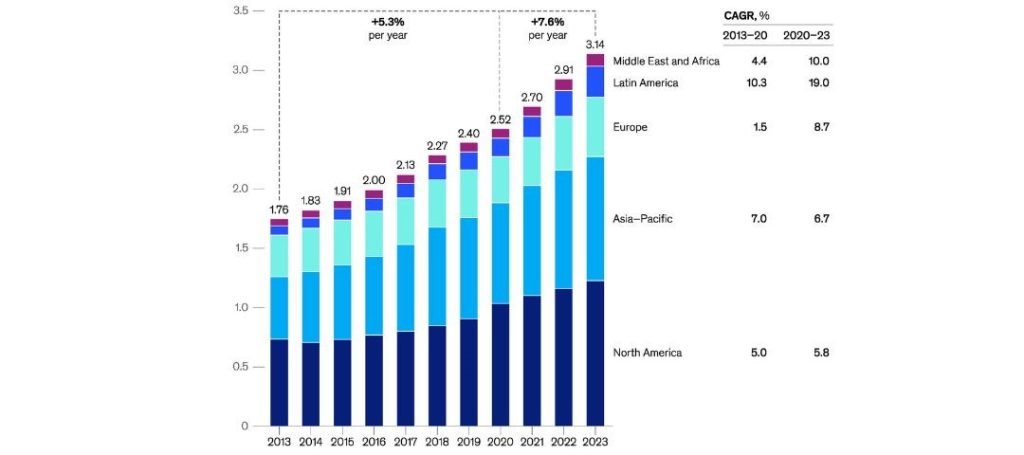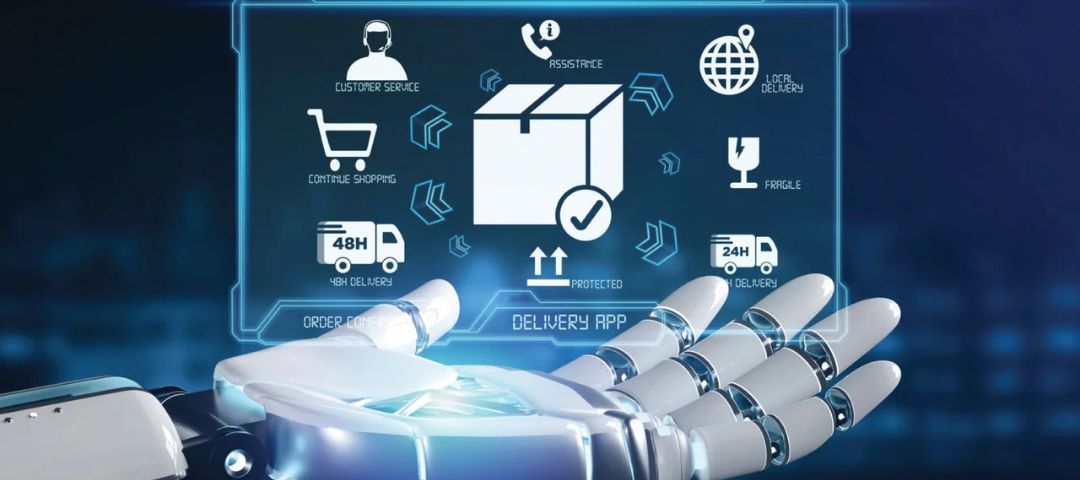A Brief on Generative AI in Retail
Generative AI or Gen AI is an advanced technology that falls under the umbrella of artificial intelligence (AI). It is used to create new content including text, images, videos, codes, music etc. through learnt patterns and data. It synthetically generates output by understanding historical input data instead of applying any sort of classification techniques like traditional AI. Some of its applications include ChatGPT which generates answer-based questions, resumes as per learnt patterns, DALL-E or MidJourney, which can create new images from text-based prompts and more. Generative AI for retail is another area of interest that has been gaining popularity in recent years due to its qualitative and creative applications in this field.
With generative AI services, retail businesses can maintain their margin as well as focus on customer engagement while progressing in the uncertain macroeconomic environment. It is reshaping financial productivity, product designing, contact centers through real-time customer support based on profiling, back-end process automation, document interpretation, fraud detection, legal and financial risk estimation, talent management in a retail environment and more. The retail industry has generated around US $240 billion as of 2022 through Gen AI-based applications. This value is surging to reach around US $390 billion and even trillion in the upcoming years with an increase of 0.7 margin points.

Growing market size of global retail industry uplifted by generative AI for retail
Gen AI Use Cases in Retail Industry
Given below are some of the detailed use cases and applications of generative AI in this industry that can enhance user experience –
Personalized Experience
Retailers can deliver hyper-personalized customer experience in retail by analyzing stored user data, historical purchases, buying decisions, preferences etc. through Gen AI. Large language models (LLMs) dynamically generate content for product recommendations, marketing mail campaigns, advertisements, product descriptions, personalized user and shopping journeys, specifically suited for individuals. This may lead to enhanced cross-selling, upselling opportunities and increased interest in goods and services that businesses offer. Generative AI in retail is also useful for strategizing dynamic pricing models that are tailored to a user’s willingness to pay, as per customer demographics, competitor pricing, market conditions etc. This leads to optimized sales, revenue generation and a likelihood of impulse purchases, for example, Amazon analyzes and uses Gen AI to power product recommendation engines that offer suggestions based on user’s browsing history, past purchases, search filters applied, style preferences etc.
Targeted Content
Retail businesses often have the requirement of producing large amounts of content for catalogs, brochures, websites, presentations, smart trash bin ads, display boards, hoardings, POS stands, and other promotional materials, which can be automated using Gen AI to save costs, time, improve utilization of resources and consistency. It analyzes product specifications and creates SEO-friendly, unique descriptions for various types of materials that are optimized for sales conversion. Moreover, it generates high-quality product and service images such as lifestyle images, mockups and effective product lines from simple text prompts within seconds, even in the absence of traditional or sample photographs. For example, H&M, ASOS, Zara and other fashion retailers create images of products in various contexts such as different sizes, settings etc. to speed up time to market instead of going through multiple photoshoots.
Virtual Assistants
Generative AI in for retail plays an important role in improving customer support by creating intelligent chatbots and virtual assistants (VA). For example, Sephora’s Virtual Artist offers beauty products over a try-on platform as per user’s preferences using Augmented Reality (AR). Chatbots and VAs utilize natural language processing (NLP) to understand and automatically respond to complex user queries and solve their issues with relevant answers related to shipping information, returns, order status etc. This represents a more personalized experience as compared to traditional rule-based systems and long wait times over customer support calls. AI-driven VAs also assist users in product discovery, that is finding suitable products as per their needs, suggesting products, providing styling advice, answering technical questions related to product features and specifications over a conversational interface.

Various Gen AI use cases in retail industry
Visual Merchandising
Gen AI assists retailers to improvise or design online stores and display products. It can also optimize layouts for physical stores and e-commerce websites, which helps in maximizing customer engagement, customer flow, conversions, product visibility and placements, based on historical sales data, interactions, foot traffic patterns and the relevancy of products displayed on the home page. For example, L’Oreal showcases virtual store environments to simulate the look and feel of product arrangements in a store or over a website in a 3D reconstruction format. It helps businesses to physically measure the impact prior to launching the website or opening a new retail store.
Inventory Management
Generative AI in retail optimizes supply chains through accurate demand predictions, forecast generation, strategizing inventory replenishment and reordering, based on weather forecasts, historical sales data, local events, macroeconomic situations etc. that affect such predictions. This helps in maintaining optimal stock levels at all times and avoiding financial risks like overstocking, understocking or stockouts leading to customer dissatisfaction. It can also simulate supply chain scenarios for route optimization and devising inventory and supplier strategies. It is useful for multinational retail chains that deal with complex supply chains and international logistics. For example, Walmart optimizes its inventory management and minimizes supply chain costs through Gen AI-based demand prediction across continents.
Product Innovation
Gen AI can be used to create new products in retail industry subsets like fashion, consumer appliances, beauty tech industry, food and beverages, by taking into consideration clothing patterns, design ideas, trends, consumer preferences, past designs to speed up development cycles and stay ahead of competitors. It can be deployed for customizable, personalized products like virtual try-on clothes in real-time as per user preferences on product color, style, material etc. For example, Nike allows customers to design personalized sneakers as per patterns, colors and materials of their choice.
Fraud Detection
Some of the most significant Gen AI use cases in retail industry are risk management and fraud detection, where the system detects unusual patterns in transactions and generates real-time alerts pertaining to security issues such as account takeovers, payment or return frauds. It can also be useful in penetration testing by simulating potential attacks, threats and security vulnerabilities in the retailer’s digital infrastructure to strengthen cybersecurity measures. For example, Mastercard utilizes Gen AI to alert personnel regarding suspicious and fraudulent transactional activities.
Deploying Generative AI in Retail User Journey
Customers appreciate passive generative AI features like review summarization, valuing them more than standalone tools, and are open to sharing data for personalized experiences through such solutions based on AI in retail industry. Let us go through how businesses can deploy Gen AI to enhance user engagement –
1. Targeting Preferences: Gen AI must be utilized to enhance established user preferences, complement current flows and value propositions. With time, users must be familiarized with the new search tools etc. on how these can serve needs that traditional methods do not. Flexible chatbot conversations, intelligent video analytics and demonstrations, intuitive interfaces and understanding customer constraints can expand their horizon of seamless shopping experience and reduce the steep learning curve.
2. Interactive Experience: Seamless integration of retail sites and platforms with Gen AI-based chatbots like ChatGPT to capture user experiences is the need of the hour. Retailers need to deploy multiple interactive archetypes for the purchase journey by combining proactive, passive and reactive experiences, such as product review summaries, to avoid presenting an excess of choices to the customer. Expert question-answer based interactions and comparison tools can also have a significant impact on the number of visits, basket size and customer retention. When embedded with user flows, NLP and search filters can also improve the time required to make purchase decisions.

Various advantages of deploying generative AI for retail
3. Value Exchange: As mentioned in the section for Gen AI use cases in retail industry, it can be used for handling personal data and deploying other security measures that form customer perception of the business. The deployed Gen AI solution should leverage their willingness to exchange data for personalized recommendations, curatorship, dedicated landing pages, app interfaces and product assortments in alignment with timing, context, pain points, personas and past preferences to inspire their product discovery process, for example, Etsy Gift mode. Retailers can also find value in customer feedback loops for gathering information and refining recommendations.
4. Building Trust: Retailers must be clear and concise about the inflow and outflow of customer data to maintain their trust, loyalty and brand reputation, where the outputs, such as product information etc. Must be error-free and genuine. All types of data handling practices must be transparent, including data usage, testing and learning approaches for client convenience and feedback systems with short-term and long-term improvements. It needs to be embedded in delivering coordinated returns, speech-to-text sales support conversations, product design mitigation, reimagining post-purchase customer relations, as well as tackling service challenges like combining expertise and conversational skills over digital channels.
Seamlessly Adopt Gen AI in Retail with KritiKal
We understand your commitment to customer primacy and can help you develop Gen AI-based virtual assistants and other retail IT solutions for real-time customer support, backend automation, cutting costs and accelerating workflows while enhancing document interpretation, multimodal similarity search, implementation of RAG-based use cases and risk management. In this blog, we read about how generative AI is transforming the retail industry by enabling personalized experiences, automating content creation, generating actionable insights for stakeholders, optimizing inventory, and driving innovation. As AI advances, its potential in retail will expand, helping businesses improve operations, enhance customer satisfaction, and drive new revenue streams. Please reach out to us at sales@kritikalsolutions.com to learn more about our Gen AI-based solutions.

Rajnish Singh currently works as a Software Engineer at KritiKal Solutions. He is proficiently skilled in native Android development, jQuery, MySQL, JavaScript, data structure and algorithms etc. With his ability to work efficiently in teams and extensive experience of working with software development, he has assisted KritiKal in delivering various projects to some major clients.



 Global
Global  United States
United States 

Jake Jackson
November 12, 2025Thought-provoking ideas. This will stay in my bookmarks.
Yahir Salinas
November 12, 2025This cleared up a lot of uncertainty — I feel more confident now.
Aleena Forbes
November 17, 2025I like how you addressed common mistakes — very practical advice.
Julius Pratt
November 19, 2025I appreciated the formatting — easy to skim and still informative.